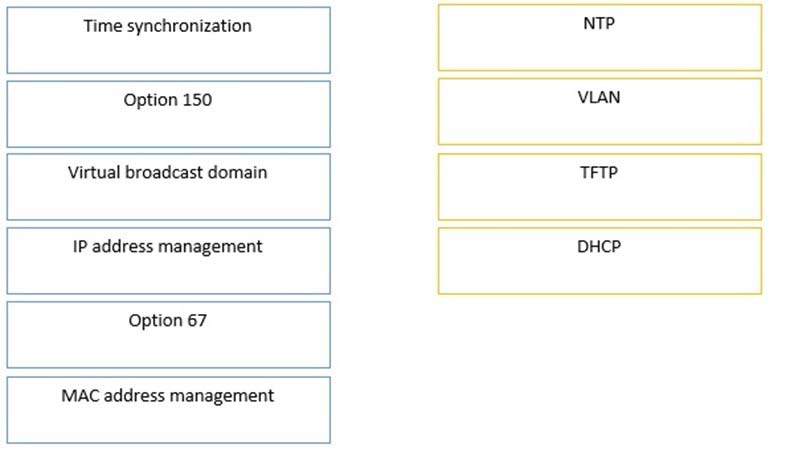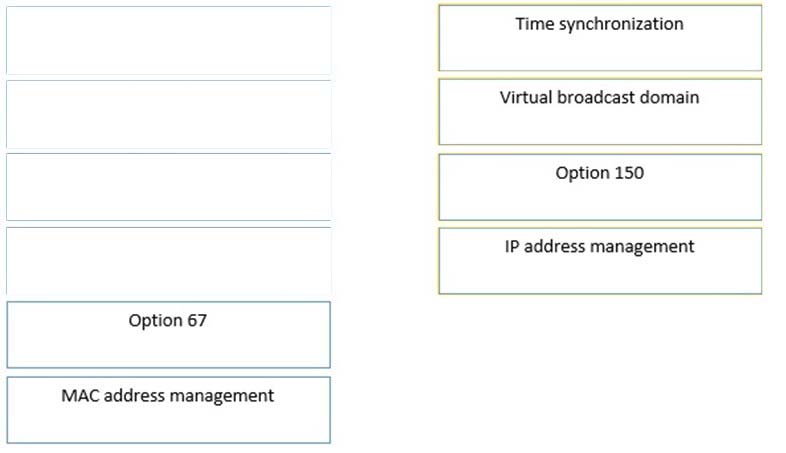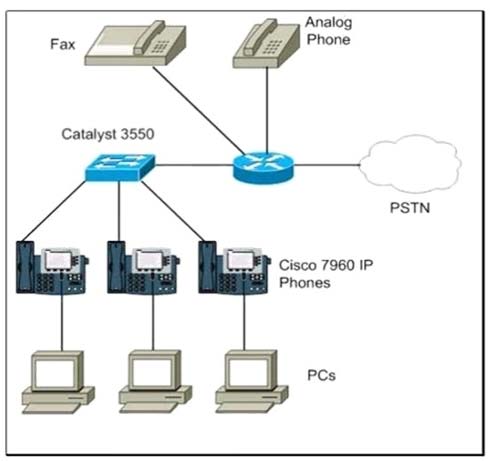CCNA Collaboration Implementing Cisco Collaboration Devices (CICD) v1.0
Question 1
In which three ways does QoS provide better network service VoIP quality? (Choose three.)
- A. minimizes priority queuing
- B. manages network congestion
- C. improves loss characteristics
- D. supports dedicated bandwidth
- E. decreases traffic priorities
- F. increases packet size
Answer : BCD
Explanation:
In general, QoS provides better (and more predictable) network service by providing the following features: "¢ Supporting dedicated bandwidth "¢ Improving loss characteristics "¢ Avoiding and managing network congestion "¢ Shaping network traffic "¢ Setting traffic priorities across the network
Reference:
https://www.cisco.com/c/en/us/td/docs/ios/solutions_docs/qos_solutions/QoSVoIP/QoSVoIP.pdf
Question 2
In which two ways does QoS provide better network service VoIP quality? (Choose two.)
- A. minimizes priority queuing
- B. increases packet size
- C. decreases traffic priorities
- D. manages network congestion
- E. improves loss characteristics
Answer : DE
Question 3
Which option is the Cisco recommended mechanism for delivering voice payload?
- A. IntServ
- B. DiffServ
- C. Policing
- D. Shaping
Answer : B
Question 4
Which two choices best describe call signaling and media flows? (Choose two.)
- A. A process used to connect two parties calling
- B. Audio or video or both transferred between two parties during conversation
- C. Protocol for end-to-end users
- D. A flow of audio and instant messaging
- E. All call control signals being delivered through a channel
- F. Data telephony, over a data network such as the Internet
Answer : AB
Question 5
DRAG DROP -
Drag the functionality on the left to the correct protocol on the right.
Select and Place:

Answer : 
Question 6
Which protocol is used to monitor active voice call quality?
- A. RTCP
- B. RTP
- C. QoS
- D. STP
- E. SDP
Answer : A
Question 7
Which server does Cisco recommend that you configure before a CUCM backup?
- A. SFTP
- B. FTP
- C. SNMP
- D. TFTP A
Answer : Explanation
Question 8
An engineer is configuring the Cisco Unified Communications Manager disaster recovery system. Which three statements about the disaster recovery system are true? (Choose three.)
- A. It requires the use of schedules for backups.
- B. Backup files are encrypted using the cluster security password.
- C. If the backup device is listed in a backup schedule, it cannot be manually deleted.
- D. If the backup does not complete within 40 hours, the backup times out.
- E. Archiving backups to tape drives is supported.
- F. SSL is used between the master and local agents.
Answer : BCE
Question 9
CUC 10.X supports LDAP integration with several widely used LDAP directories systems, including the following:
- A. Microsoft Active Directory 2000, 2003 and 2008 (support for AD 2012 only in CUCM 10.x and later
- B. Microsoft Active Directory Application Mode 2003
- C. Microsoft Lightweight Directory Services 2008
- D. iPlanet Directory Server 5.1
- E. Sun ONE Directory Server (5.2, 6.x)
- F. Open LDAP (2.3.39, 2.4)
Answer : A
Question 10
How does a MGCP CALL AGENT route calls?
- A. Route-pattern
- B. Directory number
- C. Route list
- D. Wildcard pattern
Answer : A
Question 11
Refer to the exhibit.

Which Cisco Unified Communications platform is being utilized?
- A. Cisco Unified Communications Manager Express
- B. Cisco Unified Presence
- C. Cisco Unity Connection
- D. Cisco Unified Communications Manager
Answer : A
Question 12
An engineer is adding MCU 4500 to Cisco Unified Communications Manager. Which two configuration areas within Cisco Unified Communications Manager allow the engineer to perform this task? (Choose two.)
- A. TFTP services
- B. SIP endpoint
- C. Media bridge
- D. SCCp endpoint
Answer : BC
Question 13
Which three options are the correct methods to implement end users in Cisco Unified Communications Manager? (Choose three.)
- A. Manually
- B. DHCP
- C. Bulk import using BAT
- D. TFTP
- E. LDAP synchronization
- F. Autoregistration ACE
Answer : Explanation
Question 14
Which two explanations of DTMF dialing are true? (Choose two.)
- A. DTMF dialing consists of simultaneous voice-band tones generated when a button is pressed on a telephone.
- B. The use of DTMF enables support for advanced telephony services.
- C. DTMF dialing uses INVITE messages to signal when the first digit is pressed in a new call.
- D. DTMF dialing consists of a simultaneous digital-band pulse generated when a button is pressed on a telephone.
- E. DMTF dialing is based on rows and columns of Low frequency modulation. There are 4 rows, and 5 columns, with 2 farthest right columns and being used for reserved applications.
Answer : AB
Reference:
https://www.cisco.com/c/en/us/td/docs/ios-xml/ios/voice/sip/configuration/12-4t/sip-12-4t-book/voi-sip-dtmf.html#GUID-A23A02E9-3FD2-4C3A-8ED4-
78BDC82AAEAE
Question 15
How are calls routed in an MGCP call agent?
- A. By route patterns on Cisco Unified Communications Manager
- B. By dial peers on the gateway
- C. By static routes on the gateway
- D. By a translation pattern on Cisco Unified Communications Manager
Answer : A